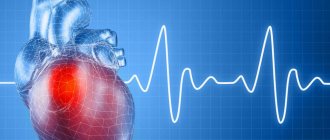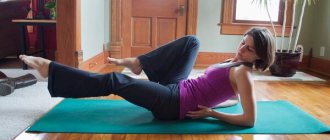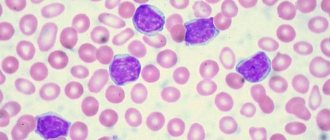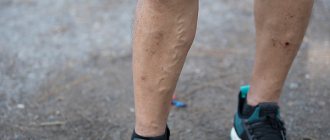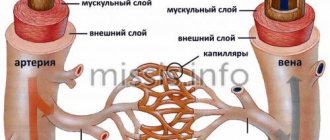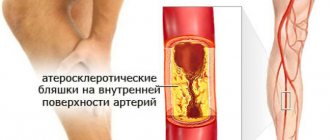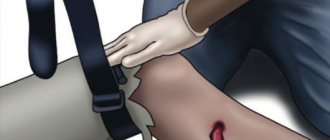Heaviness in the legs is a familiar feeling to many people, regardless of gender, age and type of activity. Heaviness in the legs is a subjective characteristic of such manifestations as: discomfort and a feeling of heaviness in the legs, a feeling of fullness and nagging pain in the calf muscles, swelling.
This feeling may be experienced by:
- children and young people who are in a period of active growth of the musculoskeletal system,
- elderly people and old people,
- athletes after long training sessions,
- pregnant women,
- overweight people.
Very often, heaviness in the legs bothers people whose profession involves heavy physical exertion and heavy lifting, staying in one position for a long time, sitting or standing, for example, office workers, doctors, teachers, drivers, and so on.
Heaviness in the legs can be a transient condition: the discomfort disappears after a night's rest, massaging the legs, a contrast shower, a short stay in the “legs above the body” position, or permanent. Regular complaints of heaviness in the legs are an “alarm bell” signaling problem veins and a serious reason to consult a phlebologist. Diagnosis of venous insufficiency at an early stage, individually selected therapy, carried out under the supervision of a specialist, is the only way to avoid further development of varicose veins.
Heaviness in the legs: causes
The most common cause of heavy leg syndrome is varicose veins. Heaviness in the legs can also be a consequence of:
- fatigue: prolonged exercise disrupts blood circulation, stagnation occurs in the calf muscles;
- flat feet: due to weak ligaments, the foot absorbs worse, pain appears when walking;
- arthrosis, arthritis: degenerative-dystrophic and inflammatory processes cause discomfort, bloating;
- arterial insufficiency: pain is the main symptom of damage to the arteries of the legs.
Sometimes heaviness in the legs is one of the symptoms of diabetes, osteoporosis, inflammation of the sciatic nerve and other diseases.
Heavy leg syndrome is most often a consequence of venous insufficiency. A narrow specialist - a phlebologist - should conduct an examination, make a diagnosis, and prescribe treatment. Self-medication and/or inadequate therapy can provoke the progression of the pathology and lead to complications, such as trophic ulcers, thrombus formation, tissue necrosis.
Circulatory disorders
Vascular diseases of the nervous system, which can result in stroke and heart attack, are becoming more common among patients. In this case, situations of so-called transient ischemic attacks are possible, when a “flickering” of symptoms occurs - weakness occurs acutely, but quickly passes. After such an incident, you cannot be complacent and assume that everything turned out okay. It is necessary to identify the cause of the incident as quickly as possible and take appropriate preventive measures.
Stroke and heart attack can occur not only in the brain, but also in the spinal cord. A spinal stroke that occurs at any level can leave a person disabled or require a long and incredibly labor-intensive recovery. It must be said that due to the structure of the spinal cord, recovery after a spinal stroke is rarely successful, even in comparison with a stroke that affects the brain.
Weakness in the limbs may result from myocardial infarction, in which case gastrointestinal symptoms are often associated - nausea, abdominal pain, bloating. Some forms of heart attack thus remain undiagnosed, since the clinical picture is not typical and “imitates” an acute disease of other organs (for example, acute pancreatitis).
The veins or arteries of the lower extremities may be affected. Chronic venous insufficiency not only reduces physical strength, leads to pain and causes aesthetic problems, but also threatens the formation or separation of a blood clot (which, if the circumstances are unsuccessful, can block the pulmonary artery - pulmonary embolism is often a fatal condition). Blood stagnation also occurs in chronic heart failure, when swelling appears in the legs.
The formation of atherosclerotic plaques in the lumen of the vessel is a common cause of gait disturbance in the elderly. The so-called “intermittent claudication” develops.
Obliterating endarteritis also manifests itself as intermittent claudication, when the lumen of the vessels gradually narrows. Raynaud's disease is manifested by changes in skin color, weakness and swelling, the trigger for which is often hypothermia or frostbite. Menopause and premenstrual syndrome can also cause transient leg weakness.
Heaviness in the legs: treatment methods
Aggressive television advertising promises relief from varicose veins and associated heaviness in the legs with the help of miracle ointments. Do not deceive yourself - there are no miracle cures. Making a diagnosis and prescribing treatment is the prerogative of the doctor. Drug therapy, including local (ointments, creams), should also be prescribed only by a phlebologist after a thorough examination and taking into account the individual characteristics of the human body, including concomitant pathology. The phlebologist, based on ultrasound and examination, selects treatment and preventive measures aimed at maintaining or eliminating venous insufficiency.
Conservative treatment methods include: selection of drug therapy, drugs from the group of venotonics (phlebotonics), angioprotectors, selection of compression stockings, physical therapy, lifestyle and diet correction.
Invasive treatment methods, when it is necessary to act directly on the venous vessels, include:
- sclerotherapy - injection of an adhesive drug directly into a vein;
- endovasal interventions (EVLT, RFO) – modern methods of heating and soldering veins;
- miniphlebectomy, including miniphlebectomy according to Varadi, is a gentle operation to remove venous nodes.
All of the above methods are widely used in our medical center, using the most modern drugs and advanced equipment.
Heaviness in the legs is the first signal to contact a phlebologist in order to anticipate serious consequences. Initiating a disease means risking your health.
In addition, treatment of advanced forms will require more time and money.
Diagnosis of heaviness in the lower extremities in men
The Yusupov Hospital is equipped with the most modern equipment. The clinic has at its disposal a modern ultrasound vessel scanning device, which makes it possible to detect changes in the vessels of the lower extremities even at the earliest stages and allows early treatment to begin. This makes it possible to improve the quality of life of patients even with severe disease. The new computer and multislice tomography device makes it possible to accurately identify structural changes in the spine and spinal cord, simulate a three-dimensional image of the affected area, which allows an accurate diagnosis to be made within a short time after the patient goes to the hospital and treatment to begin immediately. The laboratory of the Yusupov Hospital allows you to quickly and efficiently obtain an opinion on changes in the composition of the blood, in order to select an accurate conservative treatment.
Cost of treating heavy legs
You can find out prices for treatment of heaviness in the legs, the cost of admission and consultation in Moscow, as well as make an appointment by phone or leave a request on the website. To diagnose and treat heaviness in the legs, contact medical specialists in Moscow and Vidnoye
You may also be interested in:
Treatment of trophic ulcers
Diagnosis and treatment of venous insufficiency
Treatment of varicose veins with laser
phlebolog.pro
Complaints of this nature are extremely common. Often people do not know which doctor to turn to and start treatment on their own, for example taking Detralex, although the cause of pain in the legs is absolutely not related to the veins.
Due to the nature of my work, I consult about 200-300 patients monthly, not only with varicose veins. Clinic doctors en masse refer patients to a phlebologist with all sorts of complaints of pain, discomfort, burning sensation, tingling and other discomfort in the lower extremities. I perform ultrasound diagnostics on almost all patients, but if I fail to find venous pathology, I have to refer such patients to other specialists, but based on the nature of the complaints, it is highly likely that I can immediately make a correct diagnosis and refer them to the right specialist.
Based on the vast experience of consulting patients with pulling, aching, twisting pain in the calves and below the knees, I will try to explain how to determine the most likely cause of their occurrence. So as not to waste time and money on visits to the clinic or commercial clinics, but immediately contact the doctor you need.
>>Thrombosis and coronavirus. How to prevent thrombosis during and after coronavirus. >>
There are several groups of diseases that manifest themselves with approximately the same symptoms, but also have their own characteristic features. The process when the doctor purposefully compiles a list of possible causes of the patient’s complaints and then consistently excludes the unlikely ones in order to get to the bottom of the true disease is called differential diagnosis.
I usually categorize complaints according to their most likely origin in order to refer the patient to the right specialist:
1. Vascular origin (diseases of the veins and arteries)
2. Musculoskeletal system (arthrosis, arthritis, inflammation of tendons, joint capsules, muscle spasms, etc.)
3. Neurological complaints (osteochondrosis, neuropathy, etc.)
So, the list for differential diagnosis in our case will be as follows:
Vascular system
Chronic venous insufficiency, more details >> pain in the calves or legs, pulling, bursting nature. It gets worse when standing or sitting. I want to lie down and raise my legs up. The pain intensifies in the afternoon, towards evening. Sometimes there are nighttime cramps in the calves (not in the feet), often in the morning. The legs are warm or hot to the touch, and there is a burning sensation in the feet. Often accompanied by swelling of the feet or legs, worsening in the evening. After a night's rest it becomes easier; in the morning, as a rule, nothing bothers me. Walking and a cool shower also bring relief. Elastic bandaging of the feet, legs, as well as any compression knitwear significantly improves the condition. Externally, there are enlarged veins and varicose nodes on the legs, but there are forms of venous insufficiency in which there is no outwardly noticeable varicose veins.
If this is your case, make an appointment with a phlebologist
, preferably one who himself performs ultrasound diagnostics at the appointment.
make an appointment: +7 495 607 0557 at our clinic. Moscow, Bolshoi Golovin Lane, 4. KST Clinic.
Your doctor is phlebologist Drobyazgo S.V.
Atherosclerosis of the arteries of the lower extremities, more>> more often occurs in men and smokers. The feet are cool to the touch and often get cold; in the warm season or indoors, patients wear warm socks. There is hair loss on the legs, the skin becomes thin and dry. Pain in the feet or calves appears when walking a certain distance, and immediately goes away after stopping (intermittent claudication). Lying with your legs raised up is not comfortable; in advanced cases, patients wake up at night and lower their legs down, rubbing their legs. In this case, make an appointment with a vascular (or x-ray endovascular) surgeon
.
Musculoskeletal system
Flat feet and other types of foot deformities, more >> pain, discomfort occur in the area of the feet, usually after a long walk, there are night cramps in the feet. The calves or muscles along the front of the lower leg may also hurt. The condition worsens if a girl who is accustomed to wearing high-heeled shoes puts on slippers, ballet flats or other flat-soled shoes.
The pain caused by inflammation of the tendon is localized, that is, it hurts in a specific place; you can point with your finger where exactly it hurts. An orthopedic traumatologist deals with foot problems
, there is also a specialist with a narrow profile who works exclusively with the foot -
a podiatrist.
Inflammation of the joints - arthrosis, arthritis>>
pain occurs when walking, climbing stairs, or during certain movements. Clearly in the knee area or in the popliteal fossa (very characteristic). The knee area may be swollen and hot to the touch. The same
refers to the ankle joint, where it hurts to step on the foot. Osteoarthritis of the hip joint can manifest itself as pain in a certain position, in particular when the hip is abducted to the side in a lying position.
Problems with the musculoskeletal system are characterized by the following: pain is maximum at the beginning of movement, it is difficult to get up from a chair if you have been sitting motionless for a long time, or to start walking. In the process of walking or moving, it becomes easier, as they say, “you need to disperse.” You need to contact a traumatologist-orthopedist.
Neurology
Diseases of the nervous system, more >> the most common cause of nagging pain in the hip and lower leg. When the sciatic nerve is pinched (ischalgia), radicular syndrome, pain occurs along the back, outer surface of the thigh and lower leg. There is often a painful point in the buttock area, from where the pain seems to spread (radiate) down the leg. The pain is not associated with walking or exertion, and may be worse at night, but not necessarily.
Characterized by paresthesia - sensory disturbances. These include:
- crawling
- tingling
- increased skin sensitivity (it hurts to touch the skin of the feet)
- feeling of numbness (as if the leg had been put to death)
- burning sensation (while the skin temperature is normal to the touch)
In these cases, the pain is most often neurological in nature. It can be caused by osteochondrosis of the spine, radicular syndrome, but there are neuropathies with diabetes mellitus, age-related diseases of the nervous system (multiple sclerosis), etc. Contact a neurologist
If you suspect diabetes mellitus, follow-up
with an endocrinologist is mandatory.
Separately, I will say about restless legs syndrome (RLS)>>, which is very often diagnosed completely unreasonably. This disease has absolutely clear criteria, and if your complaints do not meet them, then you do not have restless legs syndrome. We need to look for another reason. The RLS criteria are as follows:
1. an irresistible urge to move your legs
2. arise at rest
3. disappear when walking or other activity
4. worsen in the evening or at night
5. It’s not a cramp or a habit of swinging your leg.
If this is your case, read my detailed article about restless legs syndrome, its diagnosis and treatment here>>
Thus, without claiming to have an absolutely accurate diagnosis, I can say with confidence that if your complaints as described fit one of the groups I described, you can immediately make an appointment with a specialized specialist.
Psychological problems
Emotions influence our lives much more than we realize. The fact is that the body’s reactions are regulated by the autonomic nervous system, another name for which is the autonomic one. This system operates according to its own laws, regardless of our will and desires. Therefore, the body's reactions - heartbeat, breathing, blood circulation, digestion, spasms - practically cannot be regulated by willpower. Our every daily experience, and even more so mental illness, affects the functioning of all organs and systems.
Weakness in the legs occurs with the following disorders:
- panic attack;
- hysteria;
- prolonged stress;
- anxiety disorder;
- depression;
- schizophrenia;
- nervous exhaustion or neurasthenia;
- chronic psychotrauma;
- neurocirculatory dystonia.
Daily overload
A load that exceeds the physiological load for a long time inevitably leads to weakness in the legs.
This is primarily excess weight, when the joints and muscles of the lower extremities bear excessive load for a number of years. Obesity destroys bones, muscles and ligaments very slowly, and it seems to go unnoticed. But if you compare the physical capabilities of people with normal weight and obesity, the comparison will not be in favor of the latter. The third trimester of pregnancy is a test for a woman’s musculoskeletal system, when she is forced to adapt to her growing body weight. Lymphostasis or elephantiasis is another reason for the increased load on the legs.

